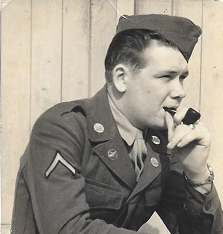Glenn joined the Army Air Corps in July, 1947 for a three year enlistment. He was discharged in April, 1950 following a 26 month tour of duty in Occupied Japan. He describes his duties in the service as “I flew a desk.” He started out in Motorpool Supply, but ended up with a 5th Air Force, 315th Aircraft Control and Warning Squadron.
He remembers vividly his initial flight into Japan from Guam. The pilot made a slight deviation in his flight path to give his passengers a view of Nagasaki where the second atomic bomb had been detonated. Glenn describes it as a large central area with absolutely nothing but sand, then gradually a ring around the sandy area where there were miles of mangled steel that slowly merged into intact buildings. It was an unforgettable sight that he still remembers well.
While serving in the Aircraft Control and Warning Squadron, he witnessed the largest radar unit available at the time as it was installed at the location of his squadron. Following this installation, his squadron was phased out as Headquarters took over. At that time, Glenn was assigned the job of maintaining the Headquarter’s SOP records (Standard Operating Procedures) until he was transferred to a smaller detachment where he was assigned duties which included a “Top Secret” rating. He stayed on this assignment until he was shipped stateside.
When he returned to the states he was offered an early discharge which he accepted rather than a new assignment since he had only three months’ enlistment left. This turned out to be fortuitous as the Korean War started on June 25, 1950 which is between the time he was discharged and the time for his full three year enlistment to end. (Service personnel who were serving at the time the war began were automatically given a one year extension of their enlistment.)
